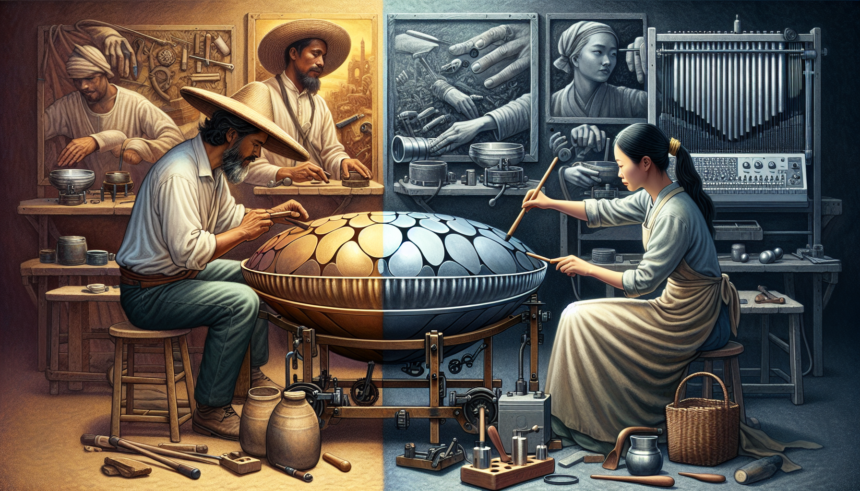<!DOCTYPE html>
<html lang="en">
<head>
<meta charset="UTF-8">
<meta name="viewport" content="width=device-width, initial-scale=1.0">
<title>From Tradition to Modernity: Transformations in Handpan Crafting</title>
</head>
<body>
<article>
<header>
<h1>From Tradition to Modernity: Transformations in Handpan Crafting</h1>
</header>
<section>
<p>
Music has always been a vital element in human culture, reflecting our emotions, aspirations, and traditions. It is a universal language that transcends barriers, and while instruments like the piano or the violin have long histories, newer instruments like the handpan have captivated the modern world with their unique soundscapes. The handpan, a relatively recent invention in the panorama of musical instruments, has undergone significant transformations since its inception. Understanding its journey from traditional roots to modern craftsmanship offers a unique perspective on how cultural contexts adapt and grow.
</p>
<h2>The Birth of the Handpan</h2>
<p>
The handpan originated in Switzerland in the early 2000s, inspired by various traditional percussion instruments. The most notable influences include the Trinidadian steelpan and the Indian ghatam. The creators, Felix Rohner and Sabina Schärer, founders of PANArt, initially called it the Hang. Drawing from Caribbean and Asian musical traditions, the Hang was designed to be both intuitive to play and rich in harmonic textures.
</p>
<p>
Handcrafted with great precision, each Hang was a work of art. However, the production process was labor-intensive and the instruments were limited in availability, often requiring potential buyers to write a letter expressing their intention to own one. This exclusivity added a layer of mystique and allure, further propelling the handpan's popularity.
</p>
<h2>Adapting to Modern Demands</h2>
<p>
As interest in the handpan surged globally, the original creators could not meet the demand. This opened the gateway for new artisans and manufacturers to enter the scene, leading to a diversity of designs and production techniques. Traditional crafting methods involved hand-hammering steel to create the instrument's shape and tuning the notes by adjusting the tension on the surface. This required skill, patience, and a deep understanding of acoustics.
</p>
<p>
Modern handpan crafting has seen significant technological advancements. While some purists argue for the authenticity of hand-hammering, many contemporary makers utilize hydraulic presses and laser-cutting technology to streamline the production process. This shift has not only increased the availability of handpans but has also introduced a standardization in quality and sound.
</p>
<h2>Materials and Sound Evolution</h2>
<p>
The initial versions of handpans were made from nitrided steel, prized for its resilience and unique tonal qualities. Nitriding, a process where nitrogen is diffused into the metal, enhances the instrument's durability and contributes to its distinctive sound. Over time, various materials such as stainless steel and composite alloys have been experimented with, each imparting different acoustic characteristics.
</p>
<p>
Stainless steel handpans, for instance, often produce a brighter and more resonant sound compared to nitrided steel. Artisans also began exploring different shapes and sizes, significantly influencing the instrument's pitch range and tonal properties. The evolution in materials and craftsmanship reflects a blend of traditional techniques with modern engineering, providing musicians with broader choices to express their artistry.
</p>
<h2>The Digital Age Influence</h2>
<p>
The handpan's journey into modernity is also marked by its interaction with the digital age. The internet has played a seminal role in the handpan's rising popularity. Social media platforms, YouTube, and specialized forums have allowed players and enthusiasts to share their experiences, performances, and knowledge. This widespread sharing has fostered a global community that fuels the instrument's ongoing evolution.
</p>
<p>
Furthermore, digital music production tools now enable musicians to incorporate the handpan into various genres, from electronic music to world fusion. Sample libraries and virtual instruments have made it possible to recreate the handpan's unique sound digitally, expanding its reach beyond traditional hand-playing. This digital integration showcases the instrument's adaptability and reinforces its place in contemporary music.
</p>
<h2>The Cultural Impact</h2>
<p>
Beyond its technical and musical transformations, the handpan has also sparked cultural dialogues. It represents a fusion of global traditions, embodying the spirit of multiculturalism. Handpans are used in diverse settings, from meditative practices and yoga sessions to orchestral performances and street busking. Its resonance with different cultures highlights music's universal appeal and the continuous exchange of artistic ideas.
</p>
<p>
The handpan community itself is a testament to cultural integration. Craftsmen and musicians from various backgrounds contribute to its evolution, ensuring that the instrument remains vibrant and relevant. Workshops, festivals, and collaborative projects further strengthen these cultural connections, enriching the global musical landscape.
</p>
<h2>The Future of Handpan Crafting</h2>
<p>
Looking ahead, the future of handpan crafting appears promising yet challenging. The balance between preserving traditional craftsmanship and embracing innovative techniques will likely continue to shape the instrument's development. Sustainability in material sourcing and production processes will also become increasingly important, as environmental consciousness grows.
</p>
<h2>Conclusion</h2>
<p>
The transformation of handpan crafting from traditional methods to modern technologies symbolizes a broader narrative of cultural and artistic evolution. It underscores the dynamic interplay between heritage and innovation, reflecting how new instruments can emerge and flourish in the contemporary world. As the handpan continues to enchant musicians and audiences alike, its journey mirrors the timeless wonder of music itself—ever-changing, always inspiring.
</p>
</section>
<section>
<h2>FAQs</h2>
<ol>
<li>
<h3>What is the difference between a Hang and a handpan?</h3>
<p>
The Hang is the original instrument created by PANArt in Switzerland, while "handpan" is a more generic term used to describe similar instruments made by various manufacturers. Though similar in structure, there can be differences in tuning, material, and craftsmanship between a Hang and other handpans.
</p>
</li>
<li>
<h3>What materials are commonly used in making handpans?</h3>
<p>
Originally, handpans were made from nitrided steel, which provides durability and distinct tonal qualities. Modern handpans can also be made from stainless steel or different composite alloys, each offering unique acoustic properties.
</p>
</li>
<li>
<h3>How has technology influenced handpan crafting?</h3>
<p>
Technology has introduced tools like hydraulic presses and laser-cutting machines, streamlining the handpan-making process and increasing production efficiency. Digital platforms and music production software have also expanded the handpan's reach and versatility in various music genres.
</p>
</li>
<li>
<h3>Can I learn to play the handpan without any musical background?</h3>
<p>
Yes, the handpan is designed to be intuitive and relatively easy to play, making it accessible even to those without a musical background. Many resources, including online tutorials and workshops, are available to help beginners get started.
</p>
</li>
<li>
<h3>Where can I buy a quality handpan?</h3>
<p>
Quality handpans can be purchased from established makers and specialized music instrument stores. It's advisable to research and read reviews or seek recommendations from the handpan community to ensure you're getting a well-crafted instrument.
</p>
</li>
</ol>
</section>
</article>
</body>
</html>From Tradition to Modernity: Transformations in Handpan Crafting

Leave a comment




